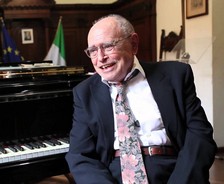
Sylvano Bussotti (Italy, Florence, 1931) entered the Florence Conservatory in 1940 where he studied harmony and counterpoint, and he also attended Dallapiccola’s courses on the piano. His intense affection for French culture was reinforced by his studies in Paris, where from 1956 to 1958 he attended Max Deutsch’s private courses. He first attracted attention with his Five Piano Pieces for David Tudor (1959), a graphic score, and for a while his works became recognizable for notational idiosyncrasy. But just as radical, and in many ways more enduring characteristic, is his affinity to connect the New Music and eroticism, as in the ‘staged concert’ La Passion selon Sade (1965–6). There is also a vein of flamboyant egotism in his creative nature: his opera Lorenzaccio (1972) – a virtuoso blending of dramatic genres most plainly influenced by 19th century grand opera – was conceived for himself as designer, producer, and star. This insistence upon the integral relatedness of concert works, pieces for dancing and sung musical theatre prompted Bussotti, from 1976 onwards, to adopt the single label of BUSSOTTIOPERABALLET as a genre description for his entire production. It was merely a further extension of this all-embracing appetite for theatrical adventures that prompted the proliferation of Bussotti’s activities as director and stage designer from the mid-1970s on. He became artistic director of the Teatro La Fenice, Venice (1975) and director of the Puccini Festival at Torre del Lago (1982–3), as well as creating a festival and theatre school around his own work. Later compositions include further operas, ballets, and concert pieces of all kinds.
Fragmentationis one of the most prominent repertoire pieces for solo harp written in the latter half of the 20th century. Its subtitle indicates that the work is intended for two harps, but only one performer – which was an original concept back in 1962, when the piece was written, as it is now. The “main harp’s” part consists of a complex piece of detailed notation, divided in ten fragments, which may be performed in various orders. The clearly delineated ten fragments are interpolated with graphic scores assigned to the second harp. In the present version, the second harp is an electric harp, tuned in a special way, following the composer’s instructions. The second harp’s interventions belong in the domain of improvisation, interrupting the flow of the acoustic harp’s score, in a way that is similar to Richard Barrett’s forest.


